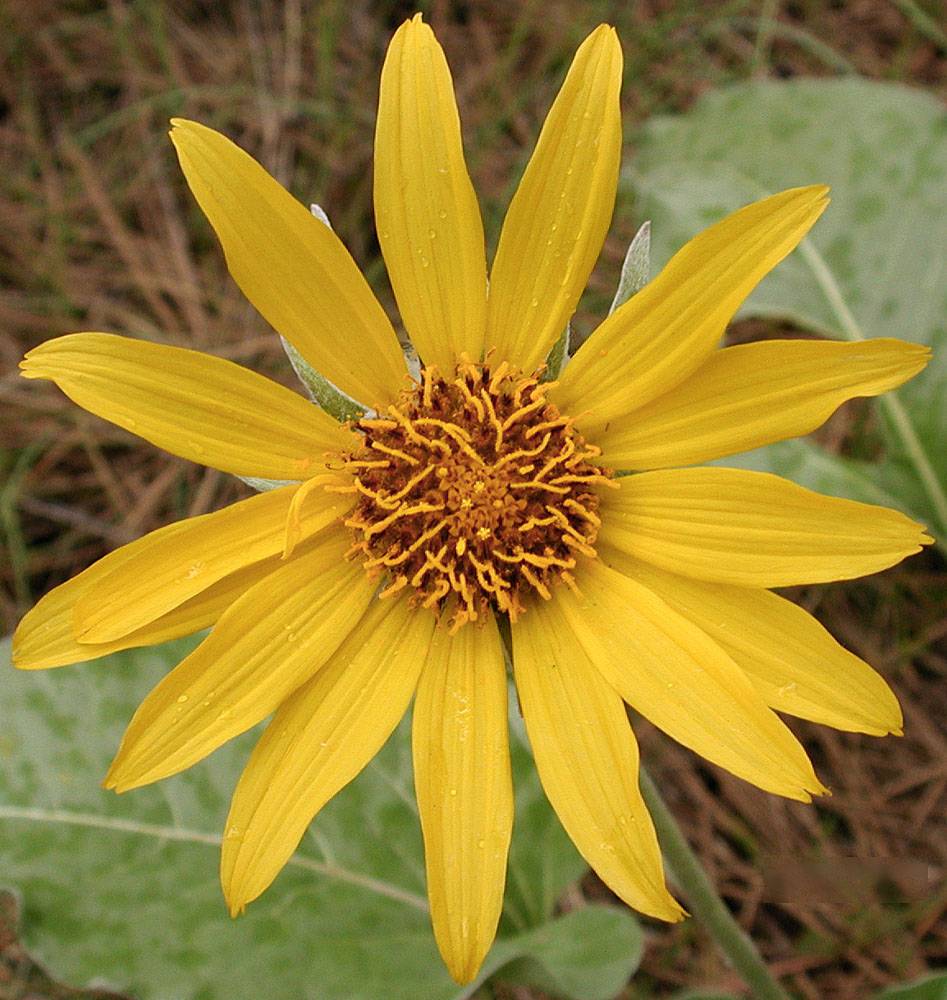Balsamorhiza macrophylla
Balsamorhiza sagittata
large-leaf balsamroot
arrowleaf balsamroot
up to 35 cm, tomentose; from single taproot.
forming clumps, 20–65 cm, gray-tomentose.
lanceolate-oblong, 1-pinnately divided;
pinnae toothed, with teeth only on lower margins;
surfaces tomentose;
basal leaves in 1–few rosettes;
blades 12–22 × 6–8 cm;
pinnae 10–36 mm wide;
petioles 7–20 cm;
cauline blades 1.5–5 × 0.3–0.9 cm;
petioles 6–9 cm.
simple; ovate, bases cordate or sagittate;
margins entire;
surfaces tomentose; more densely so abaxially than adaxially;
basal leaves in multiple rosettes;
blades 7–27 × 4.5–14.5 cm;
petioles 8–39 cm;
cauline blades 3–5.5 × 0.5–0.9 cm;
petioles 0.7–5.5 cm.
with 1 terminal head.
with 1 larger; terminal head; and rarely 1–3 smaller; axillary peduncles 0.2–13 cm.
14–18 × 25–30 mm.
terminal 10–15 × (10)15–30 mm; axillary 8 × 8–12 mm.
14–16, yellow;
rays 35–40 × 8–11 mm.
8–19 on large heads, 5–9 on small heads, yellow;
rays 25–40 × 7–18 mm.
~9 mm.
6–8 mm.
ovate-lanceolate, 20–25 × 5–6 mm;
tips acuminate, tomentose.
lanceolate, 10–32 × 3–7 mm; outer often longer, densely tomentose, especially basally.
8–9 mm, glabrous.
6–7 × 1.2–2 mm, glabrous.
10–12 mm.
9–11 mm.
=100 ± 2.
=38.
Balsamorhiza macrophylla
Balsamorhiza sagittata
Dry, open areas. Flowering May–Jul. 700–1400 m. BW. ID; east to WY. Native.
True B. macrophylla is a decaploid centered on the Wasatch Mountains in Utah and Idaho. The plants in Oregon and western Idaho are also high polyploids, but they differ morphologically from classic B. macrophylla in their denser pubescence and the shape of their leaves. These eastern plants have been given the name B. macrophylla var. idahoensis. However, further study will likely show that they have a different parentage than B. macrophylla s.s. The specific epithet “macrophylla” means large-leaved, as the leaves are much larger than those of the other members of section Balsamorhiza.
Open areas, edges of forests, open woodlands. Flowering Apr–Jul. 300–2100 m. BR, BW, Col, ECas, Owy. CA, ID, NV, WA; north to British Columbia, northeast to Alberta, east to SD, southeast to AZ. Native.
This is the most widespread species of Balsamorhiza. It hybridizes with every species of section Balsamorhiza with which its range overlaps but is itself morphologically quite uniform and easy to distinguish from the other members of section Artorhiza. Its hybrids with B. incana have been given the name B. × tomentosa.
Abigail (Abby) Moore
Abigail (Abby) Moore
- Local floras:
BC,
CA,
OR,
WA
- Local Web sites:
CalFlora,
CalPhotos,
Flora NW,
PNW Herbaria,
Turner Photog.
WildflowerSearch
iNaturalist (observations)
USDA Plants Database
- LBJ Wildflower Center
- SEINet
- Plants of the World Online
- Encyclopedia of Life
- Wikipedia
- Google Image Search




